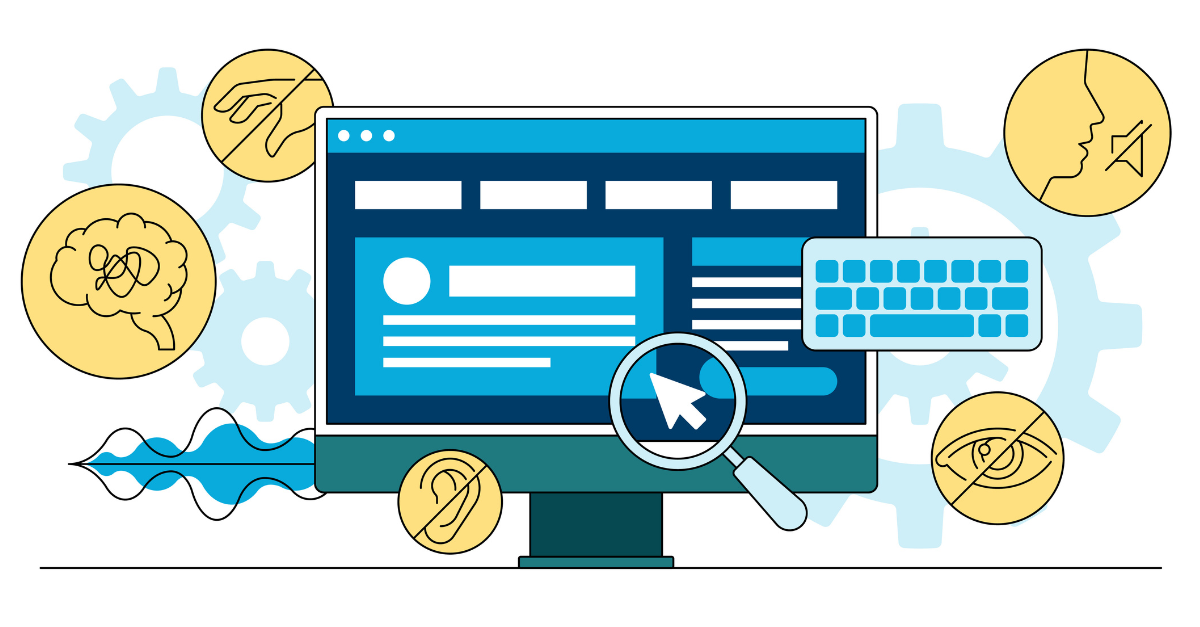Have you ever considered the extent to which your marketing campaigns are affected by accessibility measures? They actually overlap more than you’d think and are capable of powering effective and expansive campaigns.
It’s pretty cool how they tie together to guide your quality assurance and marketing strategy. Analytics can help detect any accessibility gaps in your plan and, in return, taking accessibility initiatives can lead to better results when you pull up your stats. There’s a ton of possibilities here. Keep reading to learn more!
What is Accessibility in Marketing?
We’ve spent all month covering accessibility in areas of marketing from social media to SEO. If you haven’t had a chance to check out the content, be sure to browse our blog afterwards to get up to speed.
While you’re here, we’ll recap some of the main points. Accessibility has become a top priority in all industries and an important topic of conversation when any new ideas or innovations come into play. While accessibility in the physical world looks like inclusive signs, ramps, or push to open buttons, it takes on a whole other set of expectations in the digital world.
What we need to keep track of is the information and graphics we share on our websites, our social media platforms, and in our emails. This means including alternative text or “alt text” to help out those with screen readers, utilizing captions where needed, and being conscious of our design choices in regard to everything from color to spacing to font.
Why Accessibility Matters
We’ve said it once, twice, multiple times but will gladly reiterate the importance of taking accessibility into account when designing an experience for your audience. We’ve seen plenty of flashy campaigns and creative strategies, but at the end of the day, none of it matters if only a select group of people can see or hear it.
No one purposely sets out to create marketing that only a few can enjoy. This probably goes against all instincts considering that we as marketers want as many eyes as possible on what we produce. However, by not taking accessibility seriously, you end up inadvertently excluding a valuable audience.
A great resource for understanding how to meet the needs of those with disabilities is the Web Content Accessibility Guidelines (WCAG). This is a set of design standards organized and issued by the World Wide Web Consortium that extensively covers all criteria to meet the guidelines.
Accessibility + Analytics
Taking a deep dive into your analytics data can actually do a lot to inform you about how you’re doing when it comes to accessibility. Web accessibility is vital when it comes to creating experiences that everyone can enjoy. Your goal is to create inclusive environments so that anyone who comes across your page is able to view, listen, and gain information from it without having to fill in any gaps themselves.
Your analytics dashboards and reports can clue you in on this. The data you’re looking at not only gives you user numbers but also shares user behavior. You can tell when someone lands on a page and leaves without doing anything else. This should prompt you to ask why.
A good way to start this discovery process is to initiate a quality assurance (QA) evaluation of your page. Analytics and accessibility can be looked at together. Checking the page layout for markup that appeals to screen readers can also include an analytics tag verification process. What you’re looking for are Accessible Rich Internet Application (ARIA) labels. These are attributes that function similarly to alt text and provide context to screen readers when it comes to icons.
At the same time, since analytics tag verifications involve the same buttons and links as ARIA label verifications, you are able to double check that the right analytics measurement is in place.
While you’re in this state of mind, it’s an easy transition into an evaluation of your design choices. Look over the layout of your page and see if it meets accessibility guidelines. Here’s what we recommend checking:
- Are button sizes large enough?
- Is there adequate spacing around text and images?
- Are there multiple ways to find relevant pages?
- Are there clear page titles and section headings?
Your analytics can easily guide you through this and help you determine which pages should be prioritized first in a QA. Use data like session times, bound rates, and other metrics to give you an idea of which pages work and which don’t and launch your investigation from there.
Google Analytics specifically has a Behavior Flow Report that you can utilize that walks you through the path users take from one page of your site to the next. Areas of this report can shine light on problems that frustrate your audience. You can then sort this data by audience demographics to try to interpret the issue. For example, it may show that many people leave the site after reaching the checkout page even after everything has been added to their cart and information has been filled in. Upon further inspection, you may realize the checkout button is relatively small, making it difficult to click.
Inclusive Ads Lead to Insightful Analytics
When you think of analytics, ads are obviously going to come to mind. Maximizing inclusion in marketing is a top concern for all entities, not just marketers. Google expanded its marketing toolkit this year to include more insights on accessibility marketing. In their June 2022 company announcement, they stated that:
“As marketers, it’s our job to make sure the stories we tell are fully inclusive. This also means making our marketing accessible so that all disabled people, 15% of the global population, can fully access and engage with our content, products and experiences.
We want to give marketers, advertisers and all creatives the tools they need to make work that both resonates with people with disabilities and accurately represents the disabled community.”
This in-depth toolkit includes considerations for advertisers in regard to all audiences to eliminate stereotypes in creative strategies.

With this resource on hand, advertisements can be created with an inclusive lens. This creates a welcoming experience for those that come across your marketing efforts. Including all perspectives into our ads and marketing practices can positively affect the traffic we receive.
The Takeaway
There’s still a long way to go if we truly want to improve upon our current practices. For example, web analytics doesn’t tell us if a screen reader is being used or if different versions of a site work just as effectively for people with varying levels of ability.
However, when you start thinking outside of the box and pulling ideas from everywhere, you’ll be able to gain some traction. Using analytics can help you identify any user pain points that you may not have noticed before. When you apply an accessibility lens to your marketing, you’re able to create with more people in mind.



